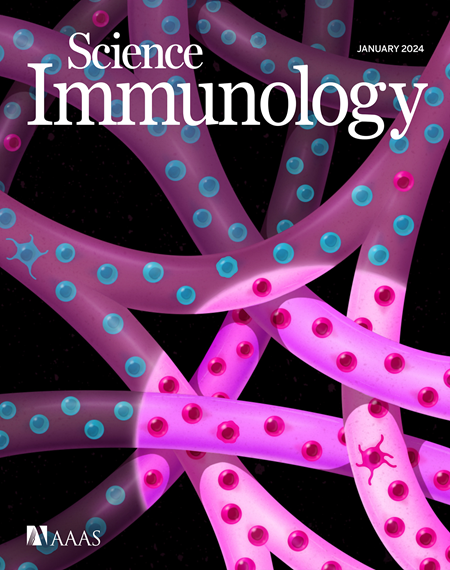Stem-like and effector peripheral helper T cells comprise distinct subsets in rheumatoid arthritis
IF 16.3
1区 医学
Q1 IMMUNOLOGY
引用次数: 0
Abstract
Peripheral helper T (TPH) cells can play pathogenic roles in human autoimmune diseases. TPH cells are proposed to be the major B cell helpers in inflamed joints in rheumatoid arthritis (RA), but whether and how TPH cells are engaged in tissue inflammation remains unclear. We demonstrate that TPH cells comprise two subsets in RA: stem-like TPH (S-TPH) and effector TPH (E-TPH) cells. These two subsets differed in transcriptome, epigenome, B cell helper capacity, spatial localization, and cell interactions. S-TPH cells displayed self-renewal capacity and were mainly found within tertiary lymphoid structures (TLSs) in synovial tissue together with B cells. S-TPH cells potently induced B cells to produce immunoglobulins. By contrast, E-TPH cells expressed effector molecules and colocalized with proinflammatory macrophages and CD8+ T cells outside TLSs. S-TPH cells could differentiate into E-TPH cells upon TCR stimulation and coculture with B cells. Collectively, our study shows that S-TPH cells play a central role in promoting TPH responses by undergoing self-renewal and seeding E-TPH cells.
干细胞样和效应外周辅助性T细胞在类风湿关节炎中包含不同的亚群
外周辅助性T细胞(TPH)在人类自身免疫性疾病中起致病作用。TPH细胞被认为是类风湿关节炎(RA)炎症关节中主要的B细胞辅助细胞,但TPH细胞是否以及如何参与组织炎症尚不清楚。我们证明,在RA中,TPH细胞包括两个亚群:茎样TPH (S-TPH)和效应TPH (E-TPH)细胞。这两个亚群在转录组、表观基因组、B细胞辅助能力、空间定位和细胞相互作用方面存在差异。S-TPH细胞具有自我更新能力,主要与B细胞一起存在于滑膜组织的三级淋巴样结构(TLSs)中。S-TPH细胞能诱导B细胞产生免疫球蛋白。相比之下,E-TPH细胞表达效应分子,并与TLSs外的促炎巨噬细胞和CD8+ T细胞共定位。经TCR刺激并与B细胞共培养,S-TPH细胞可分化为E-TPH细胞。总的来说,我们的研究表明,S-TPH细胞通过自我更新和播种E-TPH细胞在促进TPH反应中发挥核心作用。
本文章由计算机程序翻译,如有差异,请以英文原文为准。
求助全文
约1分钟内获得全文
求助全文
来源期刊

Science Immunology
Immunology and Microbiology-Immunology
CiteScore
32.90
自引率
2.00%
发文量
183
期刊介绍:
Science Immunology is a peer-reviewed journal that publishes original research articles in the field of immunology. The journal encourages the submission of research findings from all areas of immunology, including studies on innate and adaptive immunity, immune cell development and differentiation, immunogenomics, systems immunology, structural immunology, antigen presentation, immunometabolism, and mucosal immunology. Additionally, the journal covers research on immune contributions to health and disease, such as host defense, inflammation, cancer immunology, autoimmunity, allergy, transplantation, and immunodeficiency. Science Immunology maintains the same high-quality standard as other journals in the Science family and aims to facilitate understanding of the immune system by showcasing innovative advances in immunology research from all organisms and model systems, including humans.
 求助内容:
求助内容: 应助结果提醒方式:
应助结果提醒方式:


